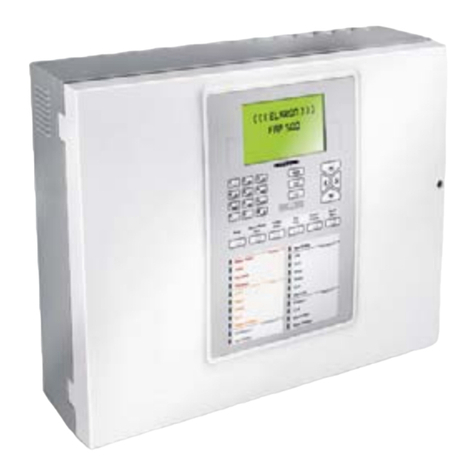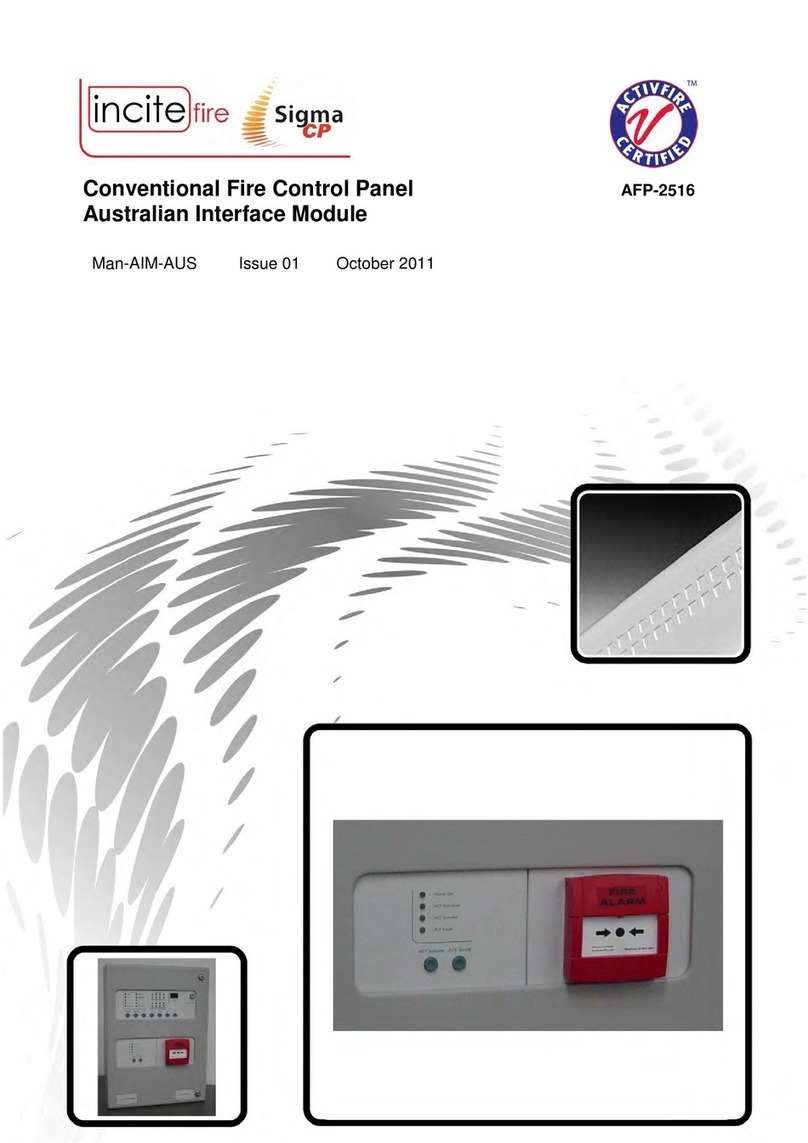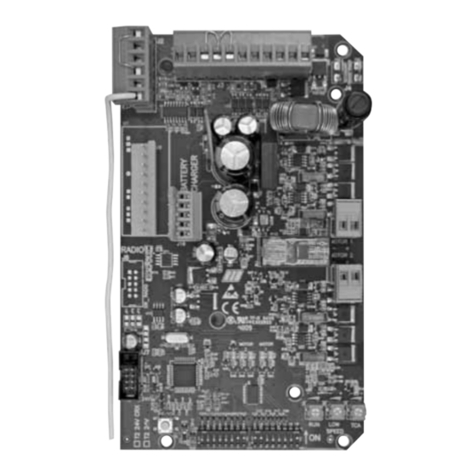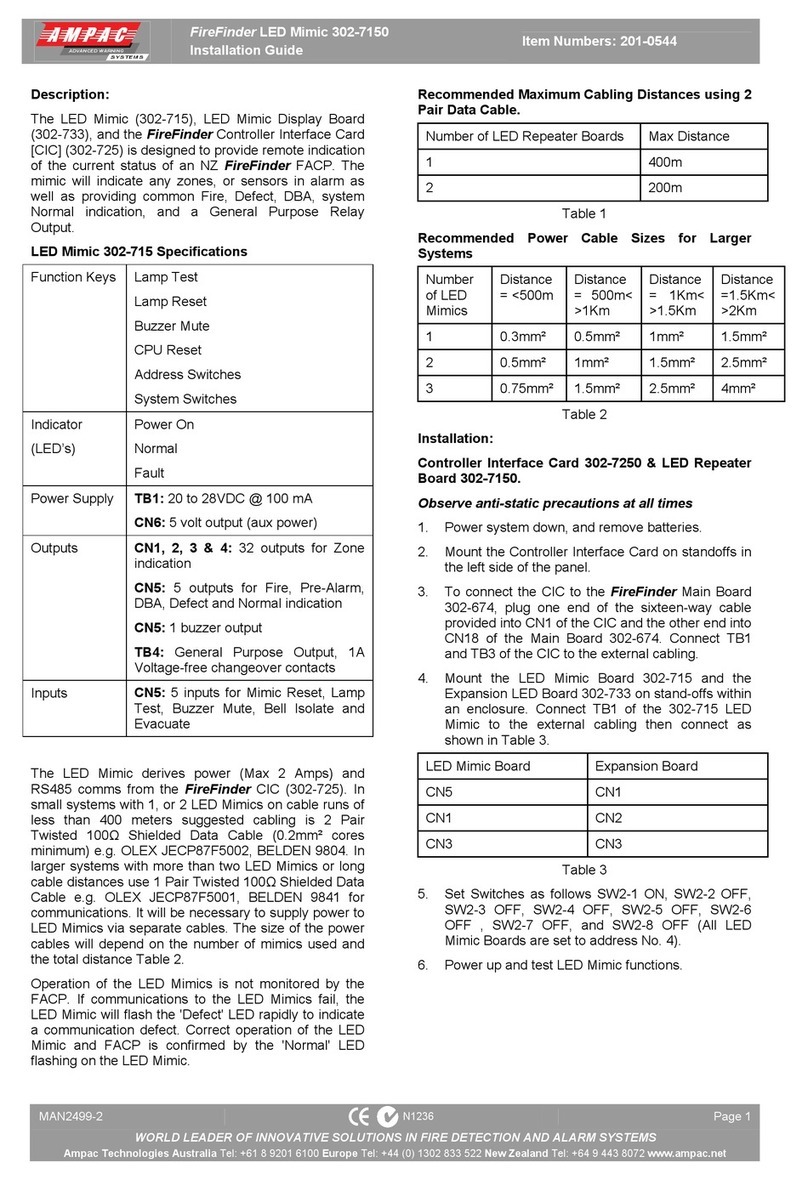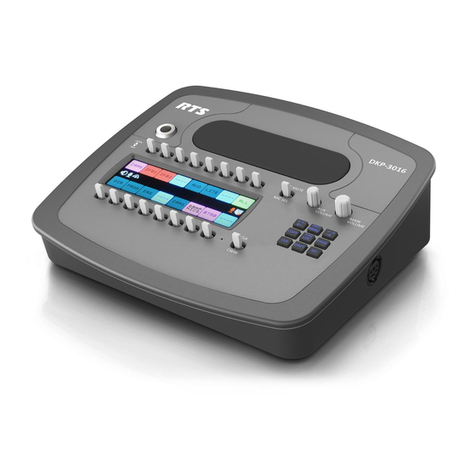Steffes CCRP How to use

CCRP9
"Commitment to Innovation"
"Manufactured in North America"
OPERATION & INSTALLATION GUIDEFOR
(Applicable to Software Version 14.0-14.9)
Comfort Control Relay Panel
(CCRP)
9 Pole CCRP 4 Pole CCRP
Off-Peak System Control

For Customer Use
PleaserecordtheserialnumberoftheCCRPbelow. Thisnumberislocatedinsidethepanel.
Retainthisinformationforfuturereference.
Serial No. _____________________________________________________________
Theequipmentdescribedhereinisintendedforinstallationbyaqualified
technicianinaccordancewithapplicablelocal,state,andnationalcodesand
requirements.
Thismanualshouldberetainedbytheowneruponcompletionoftheinstalla-
tionandmadeavailabletoservicepersonnelasrequired.
Disclaimer:
Conditionsmayoccurwhichcause thepowerlinecarriertransmitter and
receiverstohave difficultiescommunicating; therefore,notoperating
properly.In noevent shallSteffesCorporation beliable foranyindirect,
special,or consequentialdamages or lostprofits.
Incompilingthis manual,SteffesCorporation hasusedits bestjudgement
baseduponinformationavailable, butdisclaimsanyresponsibility or
liabilityforany errorsor miscalculationscontainedherein, orany revisions
hereof,orwhich result,in wholeor in part,from theuse ofthismanual or
anyrevisions hereof.
SteffesCorporation doesnot guaranteeeffective communicationof the
PLCsystemin allapplications andisnot responsiblefor anycommunica-
tionissuesoutside normaloperatingmalfunctions.
IMPORTANT
RECOGNIZE THESE SYMBOLS AS SAFETY PRECAUTIONS
It is important, both for your personal safety and to avoid possible damage to the equip-
ment and your property, that you observe the safety instructions given following these
symbols.

ComfortControlRelayPanel(CCRP)
GeneralOperation ...................................................................................................................................1
Electrical Loading Limits ......................................................................................................................1
Features ................................................................................................................................................. 2
CCRP Circuit Board Configuration Diagram..................................................................................... 3
Notes .................................................................................................................................................... 4-5
DipSwitchSettings .............................................................................................................................. 6-7
TestingPLCCommunication .................................................................................................................. 7
TypicalSystemWiringDiagram-NinePole ........................................................................................... 8
TypicalSystemWiringDiagram-FourPole............................................................................................ 9
RelayTriggeringSchematic.................................................................................................................. 10
"Example"SystemWiringDiagramforMultipleControlStrategyApplications............................. 11
Table of Contents
TC

Comfort Control Relay Panel (CCRP) Page 1
STEFFES
Comfort Control Relay Panel (CCRP)
GENERAL OPERATION
The Steffes Comfort Control Relay Panel (CCRP) is a device used for the
control of electrical loads such as ETS heaters, water heaters, baseboards,
electric furnaces, dryers, dishwashers, hot tubs, ceiling cable, etc. The
CCRP can control up to nine (9) electrical circuits using its internal, board
mounted relays. In addition, its built-in Power Line Carrier (PLC) Trans-
mitter provides communication to and control of an unlimited number of
Steffes microprocessor based heating systems, as well as any other
devices incorporating the Steffes PLC Receiver through existing power
circuits.
Upon receipt of the utility control signal the CCRP will actuate its internal
relays to control the devices wired into them. The CCRP is capable of
accepting up to six (6) separate utility control signals. This feature works
well in areas where the power company has multiple rate strategies.
If utilizing the PLC transmitter feature in the relay panel, it will send the utility control signal through the existing
electrical circuits. All Steffes microprocessor based heating systems and other controllable devices incorporating
the Steffes PLC Receiver that are served power by the same power company distribution transformer will
receive this signal and respond accordingly. The PLC control feature allows for peak control of devices without
having to do direct wiring.This feature can reduce installation costs significantly, especially in multiple unit
installations and projects such as housing subdivisions, hotels, motels, apartments, condo’s, etc.
PLC Communication is very reliable in most applications but can be affected and hindered by connection method
used, electrical layout of the application, operation of other equipment in the same electric system, dirty power, etc.
Steffes Corporation does not guarantee effective communication of the PLC system in all applications and is not
responsible for any communication issues outside normal operating malfunctions.
Maximum Fuse Size
Circuit 1 = 20 AMP (16 AMP Load, Maximum)
Circuits 2 - 9 = 30 AMP (24 AMP Load, Maximum)
Total Input Circuit Ampacity Four Pole Nine Pole
Surface Mounted 100 Amps 200 Amps
Flush Mounted 100 Amps 150 Amps
(Example: 2 - 30 AMP circuits and 7 - 20 AMP circuits = 200 AMPS)
ELECTRICAL LOADING LIMITS
Risk of electric shock.
Can cause injury or
death. DO NOT con-
nect to a circuit operat-
ing at more than 150
volts to ground.
Risk of fire. Personal
injury or property
damage may result if
loading limits are vio-
lated. DO NOT over-
load circuits.
WARNING
HAZARDOUS VOLTAGE:
Risk of electric shock. Can
cause injury or death.
System may be connected
to more than one branch
circuit. Disconnect power
to all circuits. Equipment
must be installed and
serviced by a qualified
technician.
WARNING

Page 2 Comfort Control Relay Panel (CCRP)
CCRP CONTINUED...
FEATURES
The Comfort Control Relay Panel (CCRP) is an accurate and reliable device offering the following features:
Multiple configurations available
Four Pole – four (4) relays to control four separate electrical circuits (sequenced on in two stages)
Nine Pole – nine (9) relays to control nine separate electrical circuits (sequenced on in three
stages)
Relays
30 amp, DC held, board mounted
Pre-wired with 42", 10 AWG leads
Operates on 120V or 208V/240V
Electrical Loading Limits
Maximum Fuse or Circuit Breaker Size
Circuit 1: 20 Amps
Circuits 2 – 9: 30 Amps
Total Input Circuit Fuse or Circuit Breaker Ampacity Four Pole Nine Pole
Surface Mounted 100 Amps 200 Amps
Flush Mounted 100 Amps 150 Amps
Built-in Power Line Carrier (PLC) Transmitter with 15 selectable communication channels for trans-
mitting information through the existing power lines (wireless communication) to an unlimited number
of 1000, 2000, and 2100 series room heaters, Comfort Plus systems, and the Steffes Mini Receivers
provided all systems are operating at 240V or less and are on the same power company distribution
transformer
Peak and anticipated peak (pre-peak) control signals
Outdoor temperature information for automatic brick core charging of ETS room heaters
Room temperature set back signals (external signaling device required)
Independent PLC and relay control accept up to six (6) separate power company control signals
Metal enclosures with power company seal/lockout provision Four Pole Nine Pole
Indoor (NEMA 1) – flush or surface mounted: 10" x 16" x 4.25" 14" x 20" x 4"
Outdoor (NEMA 3) – surface mounted: Not Available 12" x 18" x 4"
Available options (must be specified at time of ordering)
Current transformer (CT)
Multiple zone, 60-minute, peak override module
Capable of providing peak and automatic charge control for fluid regulated ETS room heating
systems (i.e., Steffes "S" series room heating units and most European models).

Comfort Control Relay Panel (CCRP) Page 3
CCRP
CIRCUIT BOARD CONFIGURATION DIAGRAM
(Refer to Notes on Pages 4 and 5 in this manual)
•For operational information on the green LED lights, see Note 2.
•If NOT utilizing the automatic charge control feature of the CCRP, a 4300 ohm resistor
must be placed between the two OS terminals to prevent the 2100, 3100, 4100, or 5100
Series heating system(s) from displaying Error 6 (Er 06).
•The 4-pole CCRP is configured to utilize relays 1, 2, 3, and 7.
Relay 2 Relay 1Relay 3
Relay 4
1 2 3
Dip Switches
On
Off
(Refer to Dip Switch Settings in
this manual.) Note direction of dip
switch for "ON" position versus
"OFF" position. Dip Switch 2 and
3 are "ON" in this diagram.
Transformer
Microprocessor
Software
Relay 6Relay 5
On
LED 3 (See Note 6) LED 4
Relay 8
LED 2
Relay 9
(See Note 6)
Override Jumper (J8)
LED 5
1 2 3
1 2 3
Relay 7
LED 6
Override Jumper (J9)
Off 1 2 3
N
L2
L1
A1
P2
(See Note 3)
A - Anticipated Peak (See Note 7)
OV1 - Relay #1 Override/Multiple Control Input
OV2 - Relay #2 Override/Multiple Control Input
OV3 - Relay #3 Override/Multiple Control Input
OVC - Override Common
C - Low Voltage Common
Terminal Strip Connections
OVS - Override Switch
OS - Outdoor Sensor
OS - Outdoor Sensor
R - Low Voltage Hot
OVR - Override Hot
P2
L2
A1
L1
N
OR
A1
L1
L2
P2
N
CONNECTIONS
LINE VOLTAGE
(See Note 4)
VOLT
VOLT (See Note 1)
P - Signal in from Utility Control Device (Peak Control)
OV4 - Relays #7, 8, and 9 Override/Multiple Control Input
208/240 120
E - Room Temperature Setback or Independent Relay Control (See Note 5)

0
20
40
60
80
100
120
10 20 30 40 50 60 70 80
Page 4 Comfort Control Relay Panel (CCRP)
NOTES
(Refer to the Circuit Board Configuration Diagram on page 3 of this manual.)
NOTE 1: Line Voltage Connections
This device can be powered with 120V or 208V/240V. In most applications, optimum performance is
achieved when connected to 208V/240V. The CCRP is equipped with a factory installed wiring and is config-
ured for 208V/240V. If the CCRP is to be connected to 120V, the transformer tapping MUST be changed.
To change the transformer tapping to 120V, move the wire jumper to positions P2 and N in the line voltage
connections terminal strip. (See Circuit Board Configuration Diagram for reference to proper placement of the
jumper and line voltage field wiring connections.)
NOTE 2: Green LED Lights
These lights indicate various circuit board functions:
LED 2 = When illuminated, indicates the relay panel is energized.
LED 3 = When illuminated, indicates the microprocessor has energized relays 1, 2, and 3.
LED 4 = When illuminated, indicates the microprocessor has energized relays 4, 5, and 6.
LED 5 = When illuminated, indicates the microprocessor has energized relays 7, 8, and 9.
LED 6 = When the CCRP is energized, this light should illuminate, either in a flashing or a continuous
illuminationmode, indicating the microprocessoris processing information.
No Illumination: Microprocessor is unable to process information. Check system wiring.
Continuous Illumination: Will occur any time a peak control signal is being received.
Slow Flash (4 second duration): Will occur during off-peak times. The illumination time of
the light is in direct relation to the temperature information the CCRP is receiving from the
outdoor temperature sensor. Along illumination time indicates warmer temperatures and a
short illumination time indicates colder temperatures.
NOTE 3: Outdoor Sensor
If using the CCRP with microprocessor based ETS room heating system(s) and utilizing the automatic charge
control option, an outdoor temperature sensor is required. This sensor attaches to the two “OS” positions of the
terminal strip in the CCRP. The outdoor sensor sends outside temperature information to the CCRP and the
power line carrier transmitter within sends this information to the heater(s), eliminating the need for direct wire
connections between the heater(s) and the CCRP.
•If utilizing the automatic charge control option with fluid regulated ETS room heating
systems (i.e., Steffes "S" series heaters and most European models), the CCRP must
be special ordered from the factory in this configuration.
•If NOT utilizing the automatic charge control feature of the CCRP, a 4300 ohm resistor
must be placed between the two OS terminals to prevent the 2100, 3100, 4100, or 5100
Series heating system(s) from displaying Error 6 (Er 06).
Outdoor Temperature Versus LED 6 Illumination Time
During Off-Peak Times
Outdoor Temperature (Degrees Fahrenheit)
Percentage of Indicator
"On" Time

Comfort Control Relay Panel (CCRP) Page 5
NOTES CONTINUED...
NOTE 4: Overrides (Optional, Power Company
Permitting) / Multiple Control Strategies
With the addition of the 3-zone override module to the
CCRP, peak override of 6 of the 9 circuits is possible. If
enabled, relays 1, 2, 3, 7, 8, or 9 can be used in 60-minute
intervals during a peak control period, if desired. Devices
controlled by relays 4, 5, and 6 can never be overridden.
Installation instructions for this feature are provided with
the override module. (Order item #1302060.)
For power companies desiring to control loads separately using multiple signals, the override ports in the termi-
nal block can also be used to recognize these signals and trigger the peak control.
OV1 = allows relay 1 circuit to be overridden or controlled on a separate rate/control strategy
OV2 = allows relay 2 circuit to be overridden or controlled on a separate rate/control strategy
OV3 = allows relay 3 circuit to be overridden or controlled on a separate rate/control strategy
OV4 = allows relay circuits 7, 8, and 9 to be overridden (cannot override these circuits separately) or
controlled on a separate rate/control strategy
* The 4-pole CCRP is configured to utilize relays 1, 2, 3, and 7.
NOTE 5: Room Temperature Set Back or Independent Relay Input
If using the CCRP with the 1000, 2000 and/or 2100 series room heating units and utilizing the automatic room
temperature set back feature, the addition of a signaling device is required to initiate the set back time. This
signaling device attaches to the “E” and "R" positions of the terminal strip in the CCRP. The transmitter in the
CCRP receives the set back signal, and, in turn, sends the signal (wireless) to the heater(s).
If the power company uses multiple signals for peak control of devices on different rate strategies, the “E”
terminal position can be used as the input port to trigger peak control of those devices on the separate strategy
rather than for room temperature set back.
NOTE 6: Jumpers 8 and 9 (Isolated Relay Switching - Multiple Control Strategy Applications)
These jumpers couple the relays to different input signals and enable separate control of the circuits connected
to them. If these jumpers are set to the “ON” position, the relays are controlled by the microprocessor on the
circuit board through either the “P” or “E” input terminals depending on dip switch 6 setting in the CCRP. If
Jumper 8 (J8) is in the “OFF” position, relays 7, 8, and 9 respond only to the OV4 input terminal. If Jumper 9
(J9) is in the “OFF” position, relay 1 responds only to the OV1 input terminal; relay 2 responds only to the OV2
input terminal; and relay 3 responds only to the OV3 input terminal.
Depending upon how the controllable devices are field wired into the circuit board, the positions of J8 and J9
jumpers, and dip switch 6 setting, it is possible to have the CCRP provide individual load control for up to 6
separate control strategies. If utilizing multiple control strategies, refer to Dip Switch Settings description, the
Relay Triggering Schematic, and the Example SystemWiring Diagram for Multiple Strategies in this manual.
NOTE 7: Anticipated Peak
Typically, power companies are capable of sending one signal for peak control of selected devices. There are
some instances; however, where power companies are capable of sending multiple signals for control pur-
poses. In these situations, it is possible to have on-peak hours, off-peak hours, and anticipated peak (pre-peak)
hours.
On-peak hours are those times during which a controllable load is disabled. Off-peak hours are those times
during which a controllable load is allowed to operate. Anticipated (pre-peak) hours are those times during
which ETS equipment can be prepared for an upcoming on-peak (control) period, or a time when power
companies can apply customized control of the ETS equipment. If uncertain as to whether this option is being
used in your area, contact your local power company representative.
Devicescontrolledbyrelays 4, 5, and6cannever
beoverridden.
IftheCCRPisbeingusedtodo both peak control
andautomaticchargecontrol of fluidregulated
ETSroomheatingsystems,thenpeakoverrideof
thefluidregulatedETS heater(s) is notpossible.
IMPORTANT

Page 6 Comfort Control Relay Panel (CCRP)
DIPSWITCHSETTINGS
(If using the built-in PLC Transmitter Feature for Control)
If the power line carrier (PLC) transmitter in the CCRP is being utilized for the control of the 1000 and/or 2000
series heater(s), dip switches 1, 2, 3, 4, 6, and 8 on the heater’s circuit board MUST be set to the "OFF” position.
DIP SWITCH 1: INVERT PEAK
This dip switch is used to match the utility’s signaling device to the Steffes microprocessor based heating
equipment and the Steffes PLC Receiver(s) for peak control purposes.
FACTORY DEFAULT SETTING = ON
Off = An open utility switch will signal an off-peak time to the heater (charging is enabled in the ETS
heater). A closed utility switch will signal an on-peak time (charging is disabled in the ETS heater).
On = A closed utility switch will signal an off-peak time to the heater (charging is enabled in the ETS
heater). An open utility switch will signal an on-peak time (charging is disabled in the ETS heater).
The peak control signal is a priority signal. When the room heating units or mini receiver
controlled devices are receiving a peak signal, an anticipated peak signal will be overridden.
DIP SWITCH 2, 3, 4, AND 5: TRANSMIT CHANNEL
The transmitter built into the Steffes CCRP is capable of transmitting on one of fifteen channels. The dip
switch settings in the CCRP must be set to match the channel setting of the receiving device(s).
To select the power line carrier communication channel desired use the chart below and set dip switches 2, 3,
4, and 5 to the appropriate positions. If dip switches 2, 3, 4, and 5 are all set to the "OFF" positions, the CCRP
will not transmit a power line carrier signal.
FACTORY DEFAULT SETTING = CHANNEL 3 (2 ON, 3 ON, 4 OFF, 5 OFF)
1. If utilizing the built-in PLC transmitter, a specific channel MUST be selected.
2. 1000/2000 Series heaters will ONLY receive on slow speed channels.
3. If multiple transmitters are installed on the same distribution transformer, do not use both
channels one and two. Select one of these channels along with another available "slow"
channel.
CHANNEL DIP
SWITCH #2 DIP
SWITCH #3 DIP
SWITCH #4 DIP
SWITCH #5 CHANNEL
SPEED
0 OFF OFF OFF OFF N/A
1 ON OFF OFF OFF SLOW
2 OFF ON OFF OFF SLOW
3ONONOFFOFFFAST
4 OFF OFF ON OFF FAST
5 ON OFF ON OFF FAST
6 OFF ON ON OFF FAST
7ONONONOFFFAST
8 OFF OFF OFF ON FAST
9ONOFFOFFONFAST
10 OFF ON OFF ON FAST
11 ON ON OFF ON FAST
12 OFF OFF ON ON SLOW
13 ON OFF ON ON SLOW
14 OFF ON ON ON SLOW
15 ON ON ON ON SLOW

DIP SWITCH SETTINGS CONTINUED...
DIP SWITCH 6: INDEPENDENT PLC AND RELAY CONTROL
This dip switch allows for power line carrier control of devices independent of the relay circuits.
FACTORY DEFAULT SETTING = OFF
Off = Relay circuits will be controlled at the same time as the PLC transmitter controlled devices. The
relays are coupled with the “P” input terminal.
On = Relay circuits can be controlled separate from the PLC transmitter controlled devices. The relays
are coupled with the “E” input terminal.
The CCRP is also capable of providing independent control of some of its relays separate
from each other. This feature is used in applications where multiple load control strate-
gies are being utilized. For more information on how to enable independent relay control,
refer to Note 7 in the Notes section of this manual.
DIP SWITCH 7: Negative Outdoor Temperature Calibration
This dip switch is used to calibrate the outdoor temperature sensor information downward if it is reading higher
than the actual outdoor temperature. In most situations, this procedure does not need to be performed.
FACTORY DEFAULT SETTING = OFF
Off = Standard operating position.
On =Anegative 5oF (-5oF) outdoor temperature calibration is applied.
DIP SWITCH 8: Positive Outdoor Temperature Calibration
This dip switch is used to calibrate the outdoor temperature sensor information upward if it is reading lower
than the actual outdoor temperature. In most situations, this procedure does not need to be performed.
FACTORY DEFAULT SETTING = OFF
Off = Standard operating position.
On = A positive 5oF (+5oF) outdoor temperature calibration is applied.
TESTINGPLCCOMMUNICATION
(Ifusingthebuilt-inPLCTransmitterFeatureforControl)
The PLC system is a highly accurate and reliable method of control. Communications between the transmitter
and a correlating receiver occur on regular basis. It may take up to seven (7) minutes for the transmitter to
establish initial communication, depending on the speed of the channel selected and the noise level on the electrical
systems. Subsequent communications will occur more rapidly. In the 1000 and/or 2000 series heater, the lower
right indicator light on their face plate will illuminate green continuously once the heater begins to retrieve good
signal. In the mini receiver device, the red indicator light on its circuit board will illuminate continuously once it is
receiving complete information. In the 2100, 3100, 4100, 5100, 6100, 7100, 8100, and 9100 series systems, access
the Help Menu to verify power line carrier communication.
If NOT utilizing the automatic charge control feature of the CCRP, a 4300 ohm resistor
must be placed between the two OS terminals to prevent the 2100, 3100, 4100, 5100, 6100,
7100, 8100 or 9100 Series heating system(s) from displaying Error 6 (Er 06).
Comfort Control Relay Panel (CCRP) Page 7

Relay 2 & 3 Override
Relay 7, 8, & 9 Override
the Relays and
OVC
OVR
OVS
OV4
OV2
OV1
OV3
Terminal Block
in the CCRP.)
Factory Installed
Wire Leads.
(This End is
Connected at
the Factory to
LOW VOLTAGE
CONNECTIONS
Relay 1 Override
Override Common
STEFFES
CONNECTIONS
LOW VOLTAGE
Override Hot
CORPORATION Override Switch
105
Black Circuit 2
Red Circuit 2
TYPICAL SUPPLY
Black Circuit 1
Red Circuit 1
CIRCUITS
9
8
4
3
7
6
2
240VAC SOURCE
1
BLACK
GREEN
BLACK
BLUE
BLUE
FEED
OPTION
DUAL
RED
RED
RED
RED
BLUE
BLACK
BLUE
GREEN
2003 DO NOT HAVE
MODELS 2002 AND
A RED CIRCUIT.
SINGLE
OPTION
BLACK
NOTE:
FEED
A
C
E
(SEE NOTE 1)
REMOTE
OUTDOOR
(OPTIONAL)
SENSOR
Override Module
(OPTIONAL)
P
OS
OS
R
PEAK CONTROL
SWITCH
UTILITY
Only if Anticipated Peak
Set Back is Optional
Room Temperature
TO CONTROLLED LOAD
TO CONTROLLED LOAD
(30 Amp Circuit Maximum)
(20 Amp Circuit Maximum)
The Power Company.
Is Being Utilized By
(SEE NOTE 2)
SYSTEM GROUND
CIRCUIT 3 CIRCUIT 7 CIRCUIT 9CIRCUIT 8CIRCUIT 6CIRCUIT 4 CIRCUIT 5
20 AMP MAX
CIRCUIT ONE
CIRCUIT 2CIRCUIT 1
(See Note 3)
ANTICIPATED
TEMPERATURE
PEAK CONTROL
UTILITY
SWITCH
SET BACK
ROOM
Field
Installed
Wiring
TYPICALSYSTEM WIRINGDIAGRAM -NINEPOLE
(Utilizing PLC Control with the Steffes 1000/2000/2100 Series Room Units)
A panel label is provided in the package of
screws used to mount the front panel. Apply
this label to the service panel to identify the
breaker feeding CCRP circuit 1.
IMPORTANT 1. Loads connected between L1 and L2 on circuit 1 will be uninterrupted. Loads con-
nected between T1 and L2 on circuit 1 will be interrupted. CCRP circuit 1 feeds both
output circuit 1 and the panels internal controls. Maximum fuse size is 20 amps.
2. The system grounding and bonding must be sized and installed in compliance with all
applicable codes.
3. Any loads requiring greater than a 20 amp circuit, such as a water heater, must never
be connected to circuit 1 in the CCRP as circuit 1 is only capable of controlling a
maximum of a 20 amp circuit.
Page 8 Comfort Control Relay Panel (CCRP)

Comfort Control Relay Panel (CCRP) Page 9
TYPICALSYSTEMWIRINGDIAGRAM-FOURPOLE
(Utilizing PLC Control with the Steffes 1000/2000/2100 Series Room Units)
Is Being Utilized By
PEAK CONTROL
R
LOW VOLTAGE
CONNECTIONS
Override Module
(OPTIONAL)
OS
OS
SWITCH
UTILITY
PEAK CONTROL
SWITCH
in the CCRP.)
Terminal Block
Override Common
Circuit 4 Override
Circuits 2 & 3 Override
Circuit 1 Override
CORPORATION
STEFFES Override Hot
Override Switch
CIRCUIT 3
C
E
A
P
SENSOR
(OPTIONAL)
The Power Company.
REMOTE
OUTDOOR
CIRCUIT 1
(SEE NOTE 1)
CIRCUIT 2
OV3
LOW VOLTAGE
CONNECTIONS
OV1
OV2
OV4
OVS
OVR
OVC
the Relays and
the Factory to
Connected at
(This End is
Wire Leads.
Factory Installed
CIRCUIT 4
(20 Amp Circuit Maximum)
(30 Amp Circuit Maximum)
TO CONTROLLED LOAD
TO CONTROLLED LOAD
(See Note 3)
Wiring
Installed
Field
ROOM
TEMPERATURE
SET BACK
UTILITY
ANTICIPATED
Room Temperature
Set Back is Optional
Only if Anticipated Peak
CIRCUIT ONE
20 AMP MAX
OPTION
A RED CIRCUIT.
Red Circuit 2
TYPICAL SUPPLY
Red Circuit 1
Black Circuit 1
Black Circuit 2
CIRCUITS 5
4
3
2
1
10
9
8
7
240VAC SOURCE
6
BLUE
BLUE
BLACK
GREEN
DUAL
OPTION
FEED
BLACK
RED
RED
GREEN
BLUE
BLACK
BLUE
BLACK
RED
RED
SYSTEM GROUND
(SEE NOTE 2)
NOTE:
MODELS 2002 AND
2003 DO NOT HAVE
SINGLE
FEED
CIRCUIT 2
CIRCUIT 3
CIRCUIT 1
CIRCUIT 4
A panel label is provided in the package of
screws used to mount the front panel. Apply
this label to the service panel to identify the
breaker feeding CCRP circuit 1.
IMPORTANT 1. Loads connected between L1 and L2 on circuit 1 will be uninterrupted. Loads con-
nected between T1 and L2 on circuit 1 will be interrupted. CCRP circuit 1 feeds both
output circuit 1 and the panels internal controls. Maximum fuse size is 20 amps.
2. The system grounding and bonding must be sized and installed in compliance with all
applicable codes.
3. Any loads requiring greater than a 20 amp circuit, such as a water heater, must never
be connected to circuit 1 in the CCRP as circuit 1 is only capable of controlling a
maximum of a 20 amp circuit.

RELAYTRIGGERINGSCHEMATIC
(For Use with Multiple Rate/Control Strategies Only)
OV3 - Relay #3 Override/Multiple Control Input
P - Signal in from Utility Control Device (Peak Control)
OV1 - Relay #1 Override/Multiple Control Input
OV2 - Relay #2 Override/Multiple Control Input
Terminal strip connections
E - Room Temperature Set Back or Independent Relay Control
OV4 - Relays #7, 8, and 9 Override or Multiple Control Input
ON
OFF
Relay
Relay
Relay
Jumper 8
ON
Jumper 9
OFF
Relay
Relay
SWITCH
DIP
#6
OVC - Override Common
OVR - Override Hot
OVS - Override Switch
A - Anticipated Peak
R - Low Voltage Hot
OS - Outdoor Sensor
OS - Outdoor Sensor
C - Low Voltage Common
Relay
Relay
Relay
Relay
Input Voltage
P2
L2
A1
L1
N
#4 #5 #6
#3
#2
#1 #9
#8
#7
OFF ON
Page 10 Comfort Control Relay Panel (CCRP)

Relay 9
On
OV4
OV3
OV2
OV1
C
OVS
OVR
OVC
(See Note 3)
Water Heater ETS Baseboard
Off
1 2 3
CIRCUIT 1
Baseboard Circuit
Typical
Typical
Circuit
Water
Heater
Relay 3 Relay 2
(See Note 1)
Override
CIRCUIT 5CIRCUIT 3CIRCUIT 2 CIRCUIT 4 CIRCUIT 7CIRCUIT 6 CIRCUIT 8 CIRCUIT 9
Relay 6
(See Note 2)
Jumper (J9)
Relay 4 Relay 5
Relay 7 Relay 8
Connect to "OS"
Connect to "OV3"
Connect to "C"
Connect to "E"
Switch
Connect to "P"
Connect to "R"
Switch Switch
Relay 1
(OPTIONAL)
SENSOR
OUTDOOR
Jumper (J8)
1 2 3
Override
Microprocessor
Transformer
OS
OS
P
R
E
A
"EXAMPLE"
SYSTEM WIRINGDIAGRAM FOR MULTIPLE CONTROL
STRATEGYAPPLICATIONS
1. Dip switch 6 must be "ON" to enable independent relay control. (Refer to dip switch 6 setting description in this manual.)
2. Override Jumper J8 must be "OFF" in this application. (Refer to Note 6 in the Notes section of this manual.)
3. Override Jumper J9 must be "ON" in this application. (Refer to Note 6 in the Notes section of this manual.)
Comfort Control Relay Panel (CCRP) Page 11

DOCUMENT #1200053
WARRANTY STATEMENT
SteffesCorporation (“Steffes”) warrants that the SteffesComfortControlRelayPaneldeviceisfreefrom
defectsin materials and workmanshipundernormaluseandservice. Steffes’obligationunderthisWarranty
islimitedtotherepairorreplacementofthedeviceorpartsonly which prove to be defective under normal
usewithinone(1)yearof thedateofinstallationandwhichSteffes’examinationofthereturneddeviceor
part(s)shall verify to Steffes’ satisfaction that itisdefective.Theusershallberesponsiblefor any labor costs
associatedwiththerepairorreplacementofthedeviceorpart(s),includingthecost of returning the defec-
tivedeviceor part(s) to Steffes Corporation.
ThisWarrantyisvoidifthedeviceis movedfromthepremisesinwhichitwasoriginallyinstalled. This
Warranty shall notapplytothedeviceorits part which have been alteredinanyrespect,orimproperly
installed,servicedorused,orhavebeen subject to accident, negligence, abuse or misuse.
THEABOVEWARRANTYBYSTEFFES ISEXCLUSIVEANDINLIEU OFALLOTHER
WARRANTIES,WHETHERWRITTEN ORORAL, EXPRESSOR IMPLIED,INCLUDING
ANYIMPLIEDWARRANTYOFMERCHANTABILITYOROFFITNESS FORAPARTICU-
LARPURPOSE.
Theuser assumesallriskandliability whatsoeverresultingfromtheuse ofthisdevice. Innoevent shall
Steffesbe liable for any indirect, specialorconsequentialdamagesorlostprofits.
ThisLimitedWarrantycontainsthe complete andexclusivestatementofSteffes’obligationswithrespectto
thedeviceandanypartsthereof. Theprovisionshereof may not be modified in any respect exceptin
writingsignedbya dulyauthorizedofficerofSteffes.
Warranty
W
3050 Hwy 22 North • Dickinson, ND 58601-9413• 701-483-5400
Table of contents
Popular Control Panel manuals by other brands

Panasonic
Panasonic AK-HRP1005G operating guide

Honeywell
Honeywell Morley-IAS ZX Series Commissioning manual
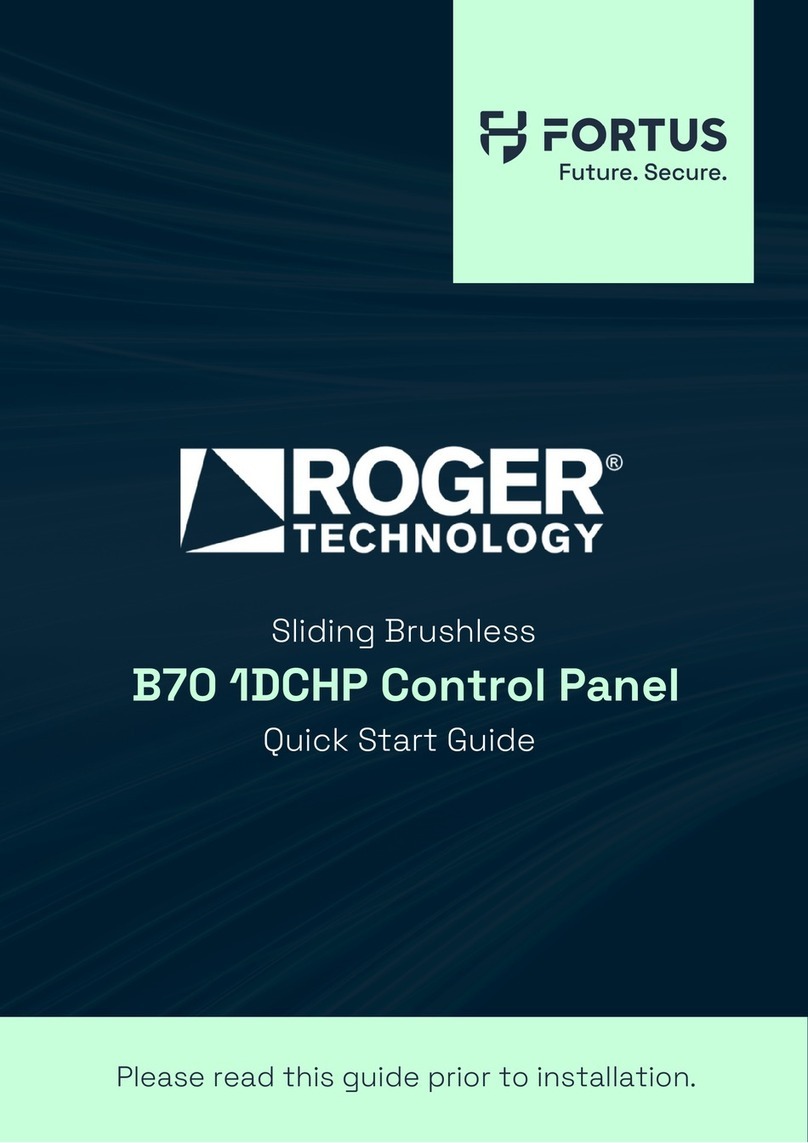
Roger Technology
Roger Technology B70 1DCHP quick start guide
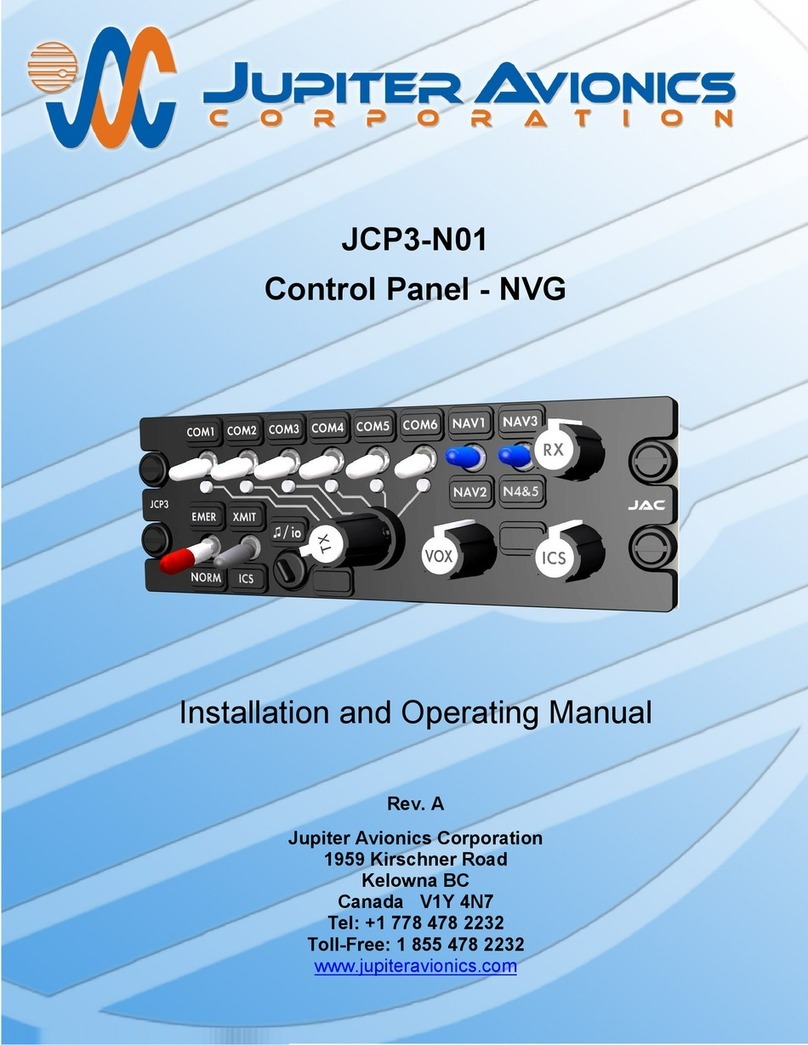
Jupiter Avionics
Jupiter Avionics JCP3-N01 Installation and operating manual
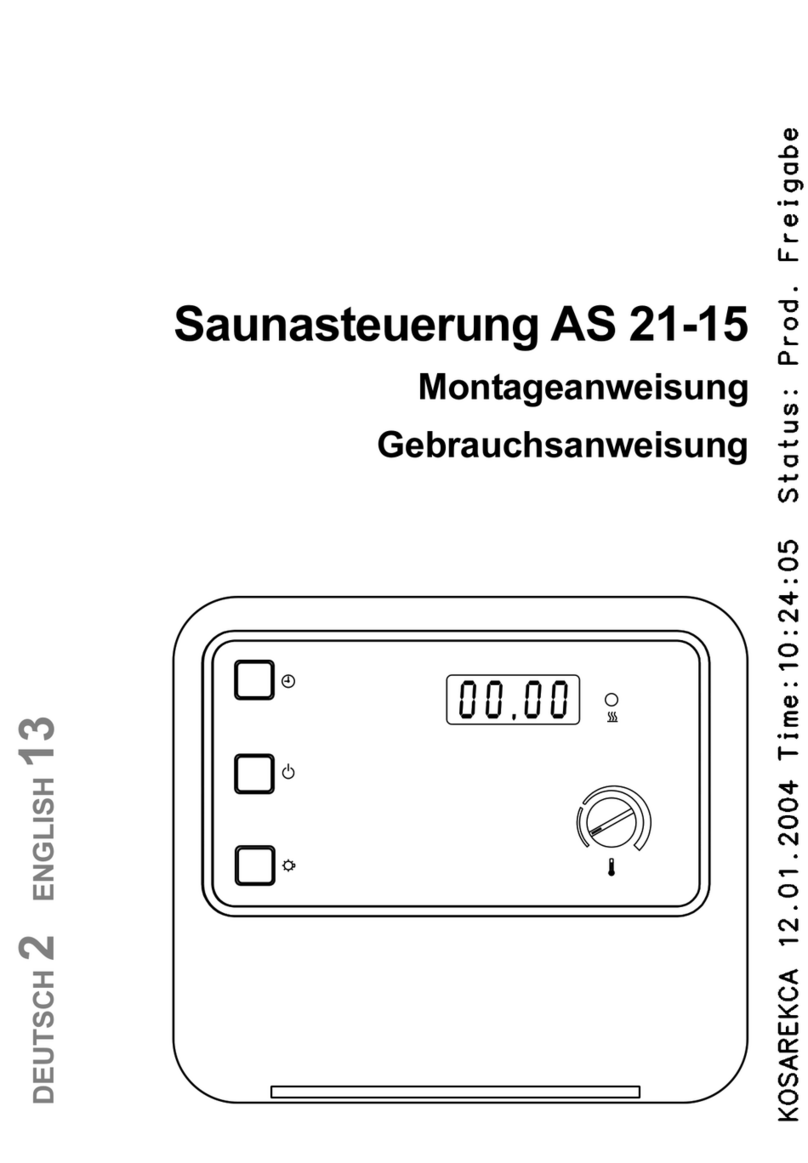
Sawo
Sawo AS 21-15 Assembling Instructions Operating instructions
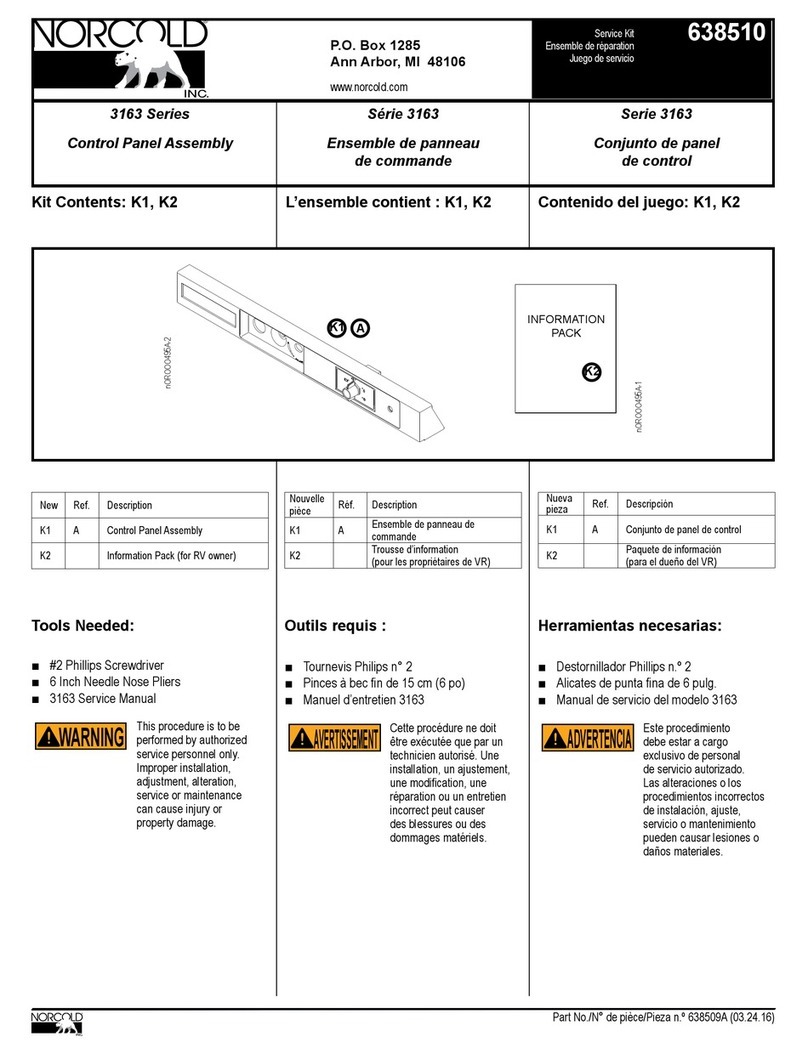
Norcold
Norcold 3163 Series Assembly
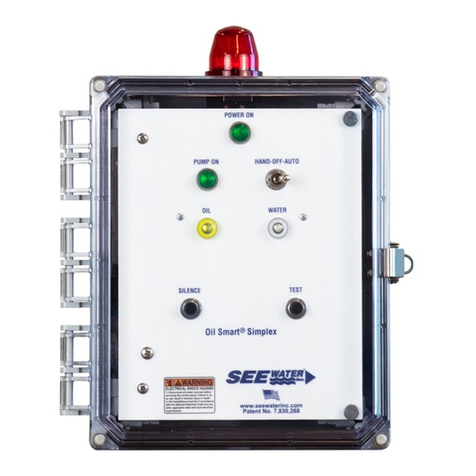
See Water
See Water Oil Smart OSSIM-30 Installation and operator's manual
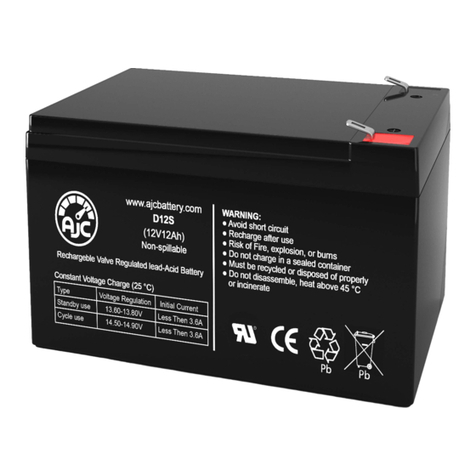
SILENT KNIGHT
SILENT KNIGHT 5204 Installation and operation manual
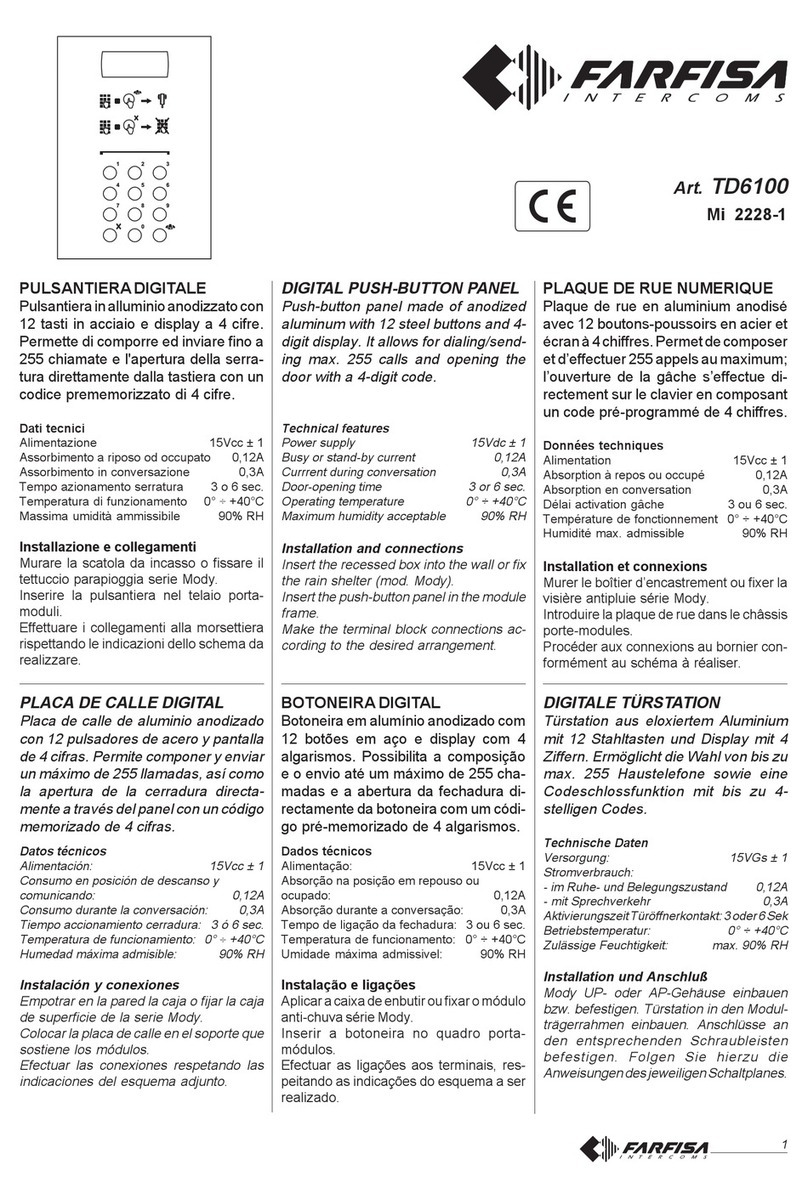
Farfisa
Farfisa TD6100 manual
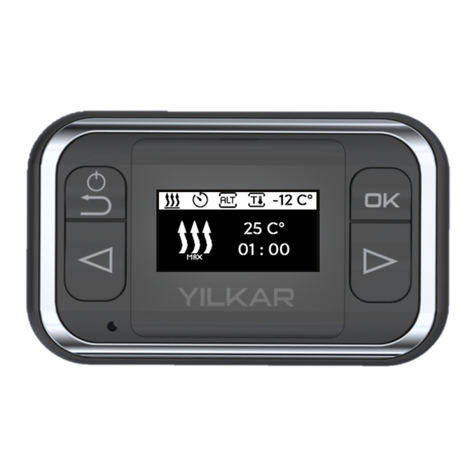
YILKAR
YILKAR YH COMFORT operating instructions
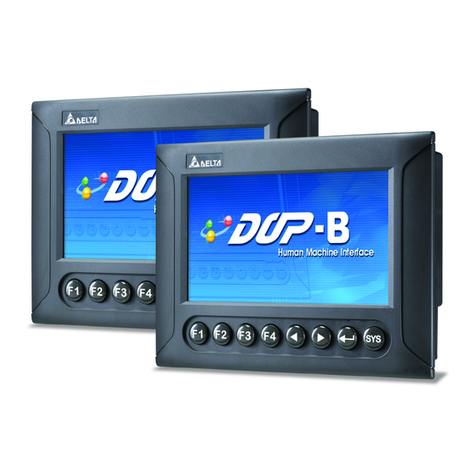
Delta Electronics
Delta Electronics DUP-B Series user manual
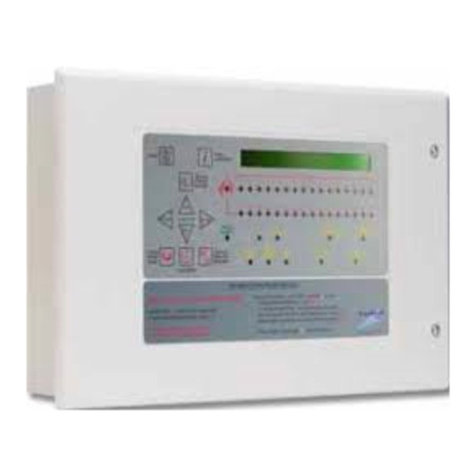
XFP
XFP NETWORKABLE ANALOGUE ADDRESSABLE FIRE ALARM CONTROL... user manual
